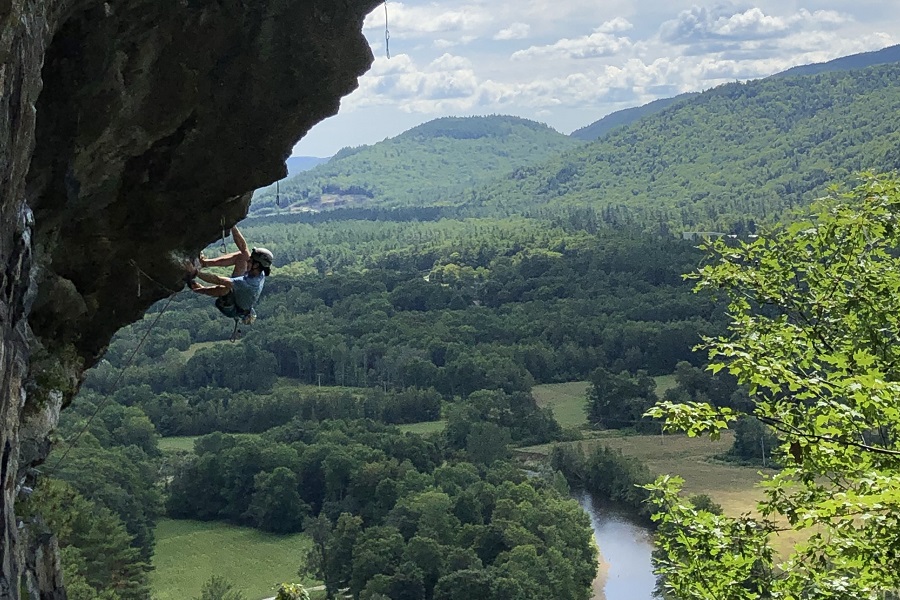I recently sent my hardest project, Predator (5.13b) in Rumney, NH. To many stronger climbers, Predator might be an insignificant walk in the park, but to a normal person like me, the journey has been significant enough for me to take the time to reflect and write a piece.
I remember the first time I walked underneath Predator years ago. I was awestruck by its majesty. It was unfathomable to me what it would be like to climb on such a route. Despite what Eric Hörst claims in his book and podcast—that any average climber should be able to climb 5.13 routes with the right amount of effort—I was skeptical.
However, somewhere deep in my mind, a seed was planted.
For years, Predator remained that way, an impossible dream. Occasionally friends would joke that we should try to send it someday, but nothing concrete happened.
Then came along Juliann and Mike, who dare to dream big. Although, to be honest, it wasn’t clear whether they were just joking, or if they believed I could really do it. I didn’t think climbing Predator was possible, but they were relentless in pushing me to get on the route. Eventually, I caved and agreed to try it once if they would stop bugging me. Furthermore, since Predator has perma-draws on it, I wouldn’t risk losing my own gear if I had to bail mid-route. So, why not?
With that calculation, I first tried Predator last fall. I was still getting comfortable with climbing 5.12 routes, and climbers who follow the grade pyramid rule would say that I still had to go through six more 5.12c, four 5.12d, two 5.13a before even getting a whiff of 5.13b. Thankfully, my friend Aaronson was willing to belay me despite not climbing the route himself.
The first attempt
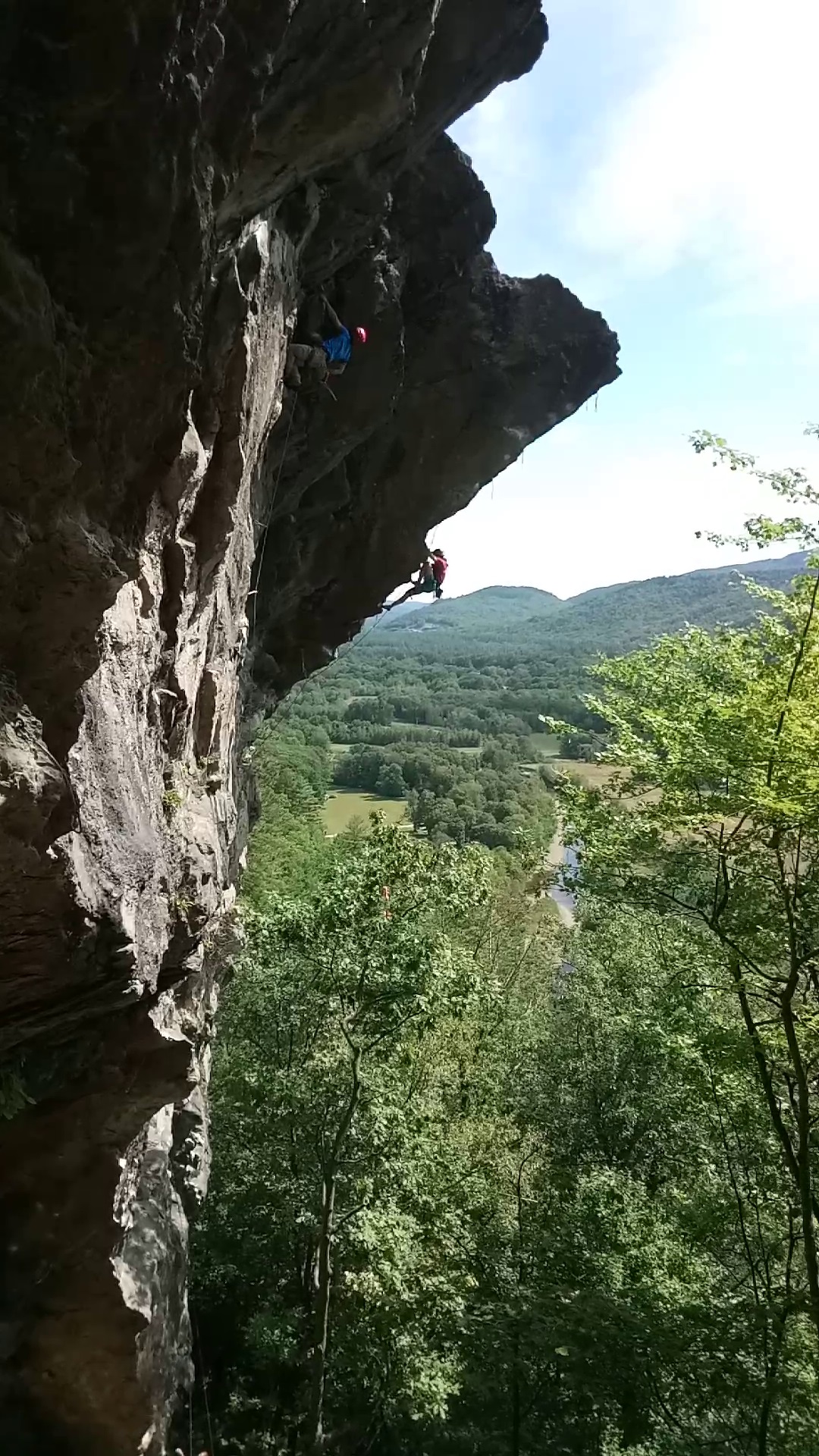
The author (in red) on his Predator (5.13b) project.
My first attempt was, expectedly, terrible. I managed to clip only two out of seven bolts on the steep overhanging section of Predator (not counting the easy vertical section). Two. It was pitiful. I had no business being on Predator.
But it felt momentous despite the poor showing. I wanted to try again. I wanted to get to the top of the route, even if it meant I had to hangdog or aid my way up.
It was difficult convincing people to do that with me. Understandably, no one wants to waste precious time on such futile endeavors when they could be enjoying more “realistic” climbs.
Two months later, I talked another friend, Alex, into belaying me. The goal was simple: just to finish the route.
On that day, I finished the route after hang-dogging for what felt like ages. I fell, aided, clipped the next bolt, lowered to the previous bolt, tried a different sequence, and repeated this cycle ad nauseam until I reached the top.
Each individual move was doable after hang-dogging and resting for a few minutes after each fall but linking everything into a nice fluid choreography felt impossible. Huge thanks to Alex for sacrificing his own climbing time to belay me, and for putting up with the looks he got from the other folks waiting in line.
Armed with this new experience, I then convinced myself that I didn’t need to send Predator. Having made it to the top of the route was good enough. I could settle for that.
But over the winter, I toyed with the idea of training and practicing for Predator again. Since I had managed to eke out each move, it meant all that’s left to do was to build up endurance. Simple, right?
That was around the time I started volunteering at a school climbing gym. As a wall staff, I seized the opportunity to set a few simulator climbs, breaking Predator down into individual smaller pieces. But attempting to link those climbs reminded me how daunting Predator is. I thought,
If I just give up on Predator, I could have so much more fun climbing easier routes. Why bother? I’ve managed to reach the top. It’s enough.
And with that, my laziness won. Or perhaps it was my ego defense mechanism. It’s easier to say that I didn’t even try rather than face the possibility of failing after trying. Predator was relegated to the bottom of my priority list. Truthfully, I didn’t care for it enough. Occasionally, I’d get on the simulator climbs. Since I had set them, I felt an obligation to at least send them individually, even if I couldn’t link them.
This half-hearted effort lasted until early spring before I completely gave up. Things changed in fall this year, after almost a year since I first tried Predator. It was a confluence of several factors.
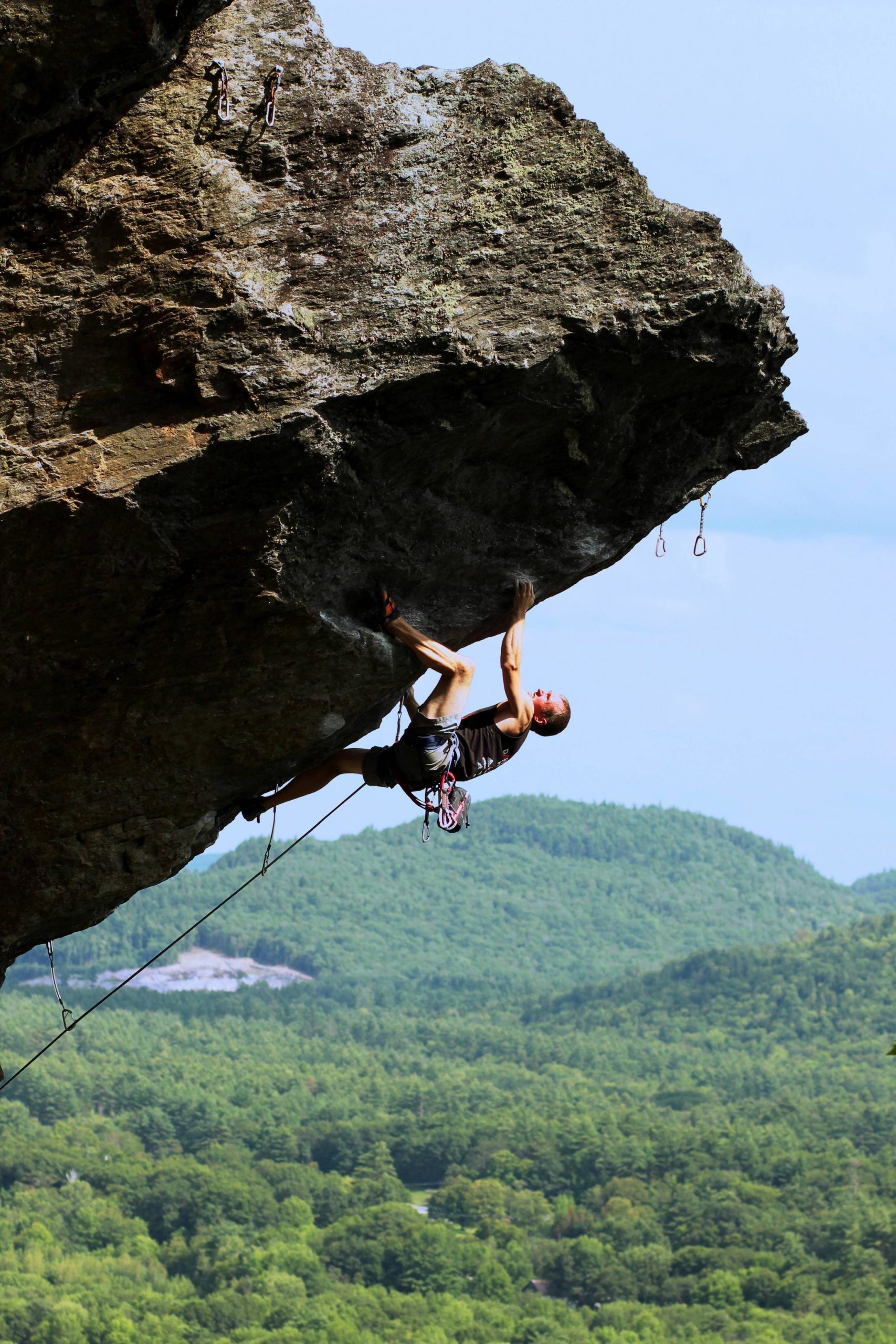
Predator in Rumney, NH. A 5.13b with a great view.
In early summer, I got a text from David, a friend who had moved out to the west coast. Due to some miscommunication, he had heard from a mutual friend that I’d set my sights on Predator and had been training for it, and he wanted to check in on my progress. It was kind of funny since I had in fact given up. But anyone who knows David knows that his psych is contagious. This was enough to resurface Predator in my mind.
Fortunately, I had the chance to get outside on a weekday with another friend Alejandro, who’s excited to try Predator too. We decided to seize this opportunity to avoid the crowd. Once again, I got shut down by Predator. But this time, I managed to get to the top without aiding. I rested after lowering off and got even farther before falling on my next attempt. Progress was made!
Even though it was a very slight improvement, that bit of satisfaction was enough to reignite the spark. Perhaps I’d get back on Predator someday. But first, I wanted to focus on another project … Nexus.
As I had been bouldering almost exclusively since winter through spring, my endurance had tanked. I had just started training my aerobic energy system after listening to Eric Hörst and Steve Bechtel talk about it on the Training4Climbing and TrainingBeta podcasts, but I was in no shape to even consider projecting Predator.
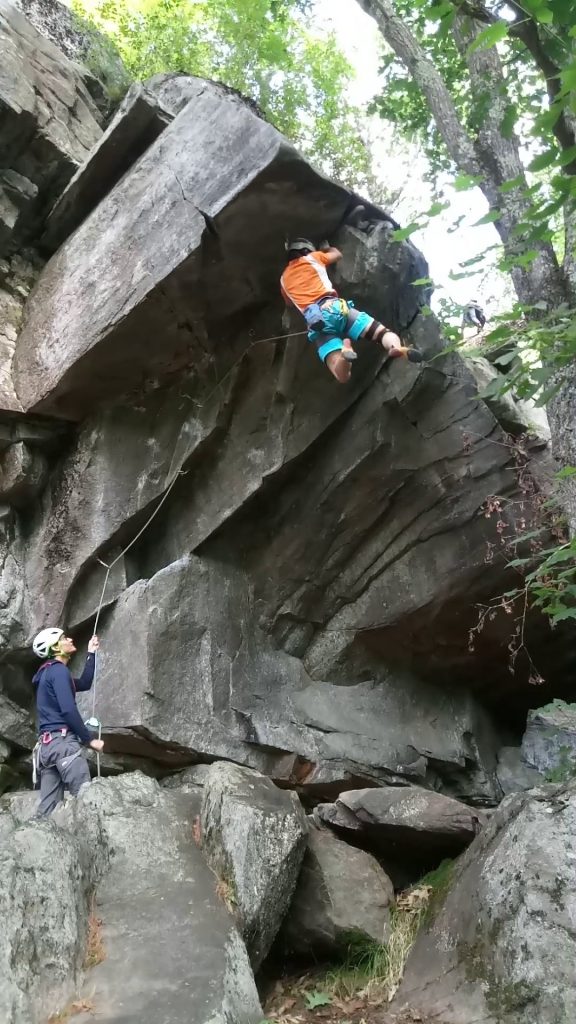
The author working Nexus (5.13a).
Nexus, on the other hand, is a short bouldery climb that took several sessions before the send. This was a major confidence booster, as it was my first 5.13a “route” after 6 years of climbing regularly (more than a decade if we count back to my first intro to climbing class). And so, I began looking for a new project. Maybe it’s time to reconsider Predator?
However, anyone who knows Nexus and Predator could tell that these two routes are polar opposites. One is a sprint with distinct cruxes; the other is an endurance test piece. But having sent Nexus, I felt confident. I became willing to commit to Predator. I told myself that it’d be a worthwhile learning process.
I made myself a promise: I’d stop by Predator to give it one or two attempts every time I went to Rumney (Huge thanks to all my climbing partners for allowing me to make this happen). I’d learn something, take notes, and make minor improvements on the next attempt. I also switched up my hangboarding protocol to build endurance. I listened to Kris Hampton, Nate Drolet and Dru Mack talk about redpoint tactics and endurance training in the Power Company Climbing podcasts (episodes 97, 109-113, 138).
It was at this point that more and more friends seemed psyched to try Predator with me. Or maybe they were all just being polite, seeing that only two of them actually tried it. Regardless, psych was high.
Then came a terrible session. My movements were sloppy, I had to readjust multiple times on several holds, I made awkward clips in order to compensate the off-balance. The climb just didn’t flow and I fell earlier than expected. While a lack of progress might be frustrating, a regression is downright demoralizing. I had to dig deep to convince myself that these were still teaching moments. “What did I learn?,” I asked. I obsessively went over what I discovered: “cross-pinch here instead of gastoning it,” “add a high step here,” “the kneebar feels better in this angle.”
My next attempt was not much better. I had modified a body position on the fly and had excess rope out as a result. I got a rope burn on my hand while boinking up the excess rope. I even dropped my chalk bag mid-climb. But I convinced myself to not write off Predator yet. “Still learning,” I told myself.
This was my version of “putting money in the bank” as Chris Heilman described it—my immediate goal was to learn, and I did achieve that. I also remembered her advice of having a “funnybone goal” and her “Rule Number Six” joke (TrainingBeta podcast episode 96). I laughed at my mistakes and the silliness of the situation.
That night I researched some videos online to gain more insights about the route. I went through my own sequence in my head …
During the next session, I went in without expectations. It couldn’t get any worse than the previous session. Instead, I would just apply what I learned, and try to discover something new on this attempt. I made the first move, then the next, and the next … Somehow, I did not fall off. The climbing flowed. I kept getting surprised by each additional hold I latched. Before I knew it, I had reached a new high point on the route. I could hear the other climbers yelling encouragement from the base. I could feel my forearms burning, but I kept going until I finally hit the brick wall and fell … just one move away from the top chains. Having spent all my energy on that single attempt that day, I called it quits.
The obsession began
For the next two weeks, I kept reviewing the video my friend Dennis took of my last attempt. I noticed I made moves that I wasn’t conscious of—minor feet shuffles, slight twists in the hips, high steps. I heard someone’s remark in the background about skipping the last bolt.
I learned. And over time, something strange happened. As I watched the video, I began to feel like I was physically climbing the route. It wasn’t quite the same intensity, but my heart rate would increase and decrease as I imagined moving through the crux sequences and rest positions. My hands would sweat. My legs would tense up as I watched myself doing the deadpoint.
I used to be on the fence regarding the power of imagery and visualization, but I’m sold now.
On the day before the send, anxiety began to build up. Luckily, I chanced upon a video of Steve Townshend. In it, he shared an anecdote about setting aside frustration and just having fun. It resonated. I should be grateful that I could have fun climbing outside. It’s only early October and I have time to learn and try again. The send will come when I am ready. I relaxed.
But I got anxious again the next morning. I felt a knot in the pit of my stomach. I wanted the send so badly. The first attempt that day did not go well. I fell on a move that I thought I had wired down.
The pressure began getting to me. I could almost hear my friend Justin’s chiding voice about “wasted opportunity.” I wondered how many more weekends are left before it gets too rainy or cold in New England. I questioned my decision months ago, “Would I have been happier to have tried and ultimately fail, or to not even try at all?” My answer was illuminating:
Come on, let’s be honest. They both suck.
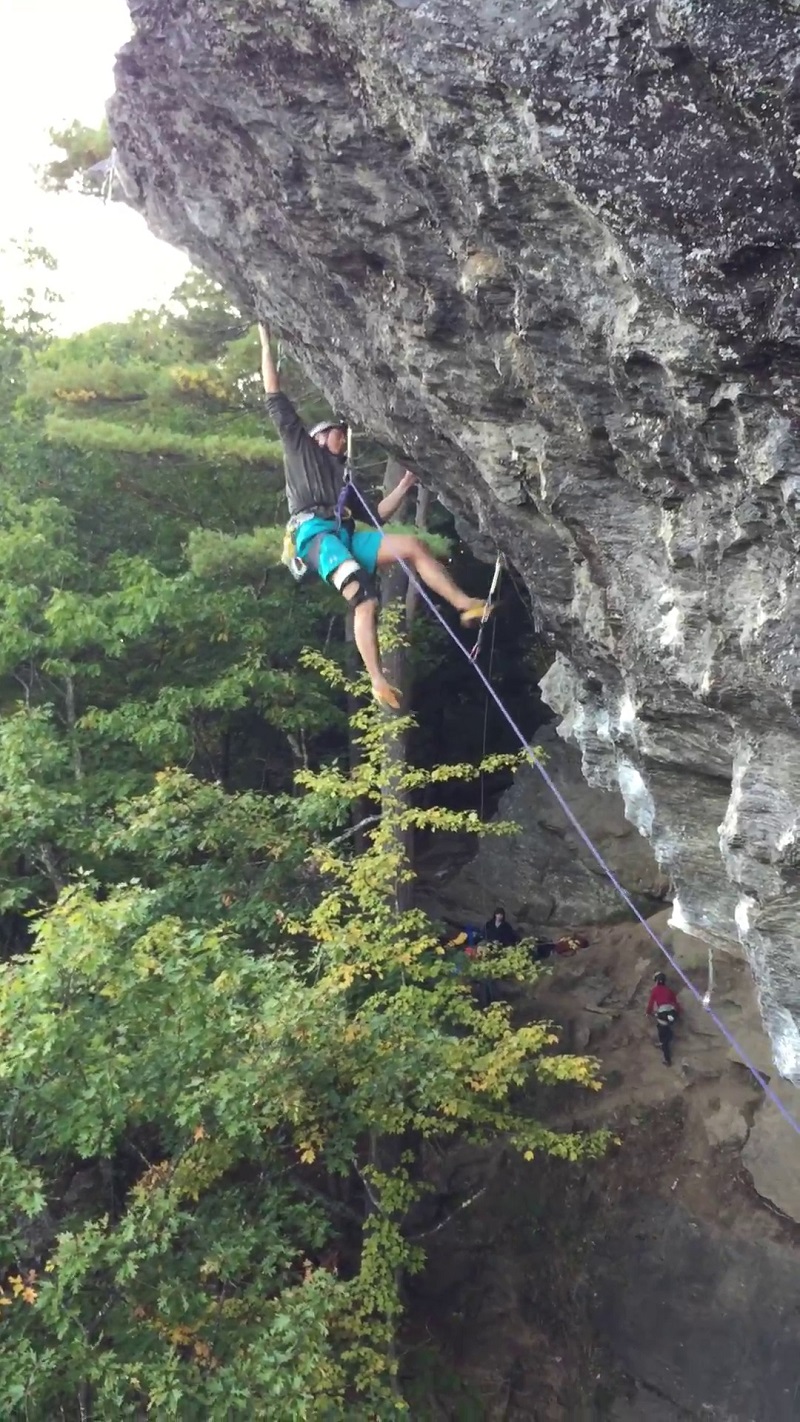
Dead point move on the send of Predator.
In an effort to not ruin my whole day, I forced myself to make up something that I had learned. “What did I learn? … Nothing. No, what did I learn? If things were perfect, then I would have sent. So, what failed? Um … Everything? No, if it was that bad, I wouldn’t have even made it that far. So, what specifically could be improved?”
Eventually, I came up with a few items. “One, be confident and don’t psych myself out. I’ve made good links on this climb before, and the body knows what to do. Just let it flow. Two, the kneebar pad needs to be adjusted. I had scratched my knee, and the pain made me unwilling to commit, that’s why I kept sliding off. What else? I could still do the deadpoint despite not feeling 100% rested. Good, remember that. Also, I need to be more accurate. So, look at the next hold before I move.
Most importantly, have fun. Remember Dru Mack’s mantra: ‘Try hard, have fun.’ Remember Ward Smith’s autograph: ‘The best climber is the one having the most fun.’ ”
I smiled as I recalled how I’d nudged Dennis to get Ward Smith to autograph his guidebook two weeks ago.
I took a long rest, calmed my racing mind, stuffed myself with some donuts, and washed them down with coffee. I belayed a friend, and just tried to enjoy the present moment. When I felt recovered, I went through my pre-climb routine. This time, I took an extra moment to clear my head of all expectations, to remind myself that this is just another learning opportunity. And then I started up the route.
To my utmost surprise, I sent. I couldn’t even say I remember much from that final run. I remember feeling pumped. I remember noticing a bleeding finger mid-climb and thinking I was going to slip on my own blood. And the next thing I knew, I had clipped the chains, topped out above the anchors, and was yelling at the top of my lungs. It was utterly unexpected.
Upon reviewing the send video (huge thanks to my quick-thinking friend Julie who was climbing on an adjacent route), I had made even more unconscious moves and adjustments than I’d realized and had used several footholds that I never once considered in any of my previous attempts.
Reflecting
To those who haven’t heard of the initial phase of this project, it might seem that I made light work on Predator. Two months is what they see. A friend even commented that it had seemed so anti-climactic; that I had sent a “long-term” goal so quickly and easily. Some folks told me that I was (and still am) climbing below my limit. But I disagree.
Working Predator has been quite the roller-coaster. Although it isn’t an epic multi-year mega project, it took over a year since the first time I got on the route. During this time, I built simulator climbs. I hangboarded. I climbed on a 45-degree wall to build endurance and practice recovery mid-climb. I ARCed. I did linked circuits, climbing up hard problems and down on random holds rather than the commonly prescribed 4x4s so I could practice loading and recovery on the wall. I spent hours at the school climbing wall, planned my schedule so that I avoided peak-hour crowds. I canceled my bouldering gym membership since that style of climbing didn’t match the demands of Predator. And during each session, I asked what had worked, what failed, what to improve next. I learned by reading books and listening to podcasts. In the weeks leading up, I reduced the number of climbing days to only twice a week to make time for recovery. I gave up sugary snacks when I wasn’t at the crag (although I didn’t lose any weight, darn). I practiced visualization.
All things considered, that’s more than just a few sessions worth of effort. And I’m proud of it. There is something sweet and thrilling about trying hard and achieving something you thought was out of reach. I doubt I would have enjoyed the send as much as I do now if I had trained for a few more years and gotten stronger before trying it. Or perhaps I would never even try it had it not been for Juliann and Mike. Some folks like to “save” a hard route for the future when they are much stronger, but perhaps they are missing out on an important opportunity.
Through this process, I learned a few things
1. It is very important to surround yourself with people who dare to dream big, who believe in you, and who are supportive of your dreams.
It takes a village to achieve your goals. I wouldn’t have been able to do this if not for my friends who pushed me, cheered me on, and made concessions for me to try and work Predator. Related to this point, don’t underestimate the power your words and actions have on others around you. (Side note, shout-out to Eric Hörst, Kris Hampton, Nate Drolet and Neely Quinn for making their training content free and available to the wider community.)
2. Adopt a growth mindset.
Things will inevitably go south sometimes, but trust in the process. Keep your eyes on the goal, stay committed, and believe you will get there. And even if you don’t, the journey itself would have taught you tons.
3. And when it’s performance time, let go of all expectations.
There is less pressure without expectations. Trust in your preparation and past experience. Granted, this is much easier said than done, and I’m still trying to master this.
I really cherish this experience, and hope to apply what I learned to future goals, be it in climbing or in life. But first, I’m going to get myself a celebratory ice cream.
Related Posts
- Stacking Paper: How Climbing Strength and Climbing Skills Build One Day at a Time
- China Doll — Love, Obsession, and Hard Trad Climbing with Heather Weidner
- Train by Doing — Madaleine Sorkin’s Training Approach
- I’ve Gone Up 8 Grades While Traveling The World – Here’s How (Chapter 1)

